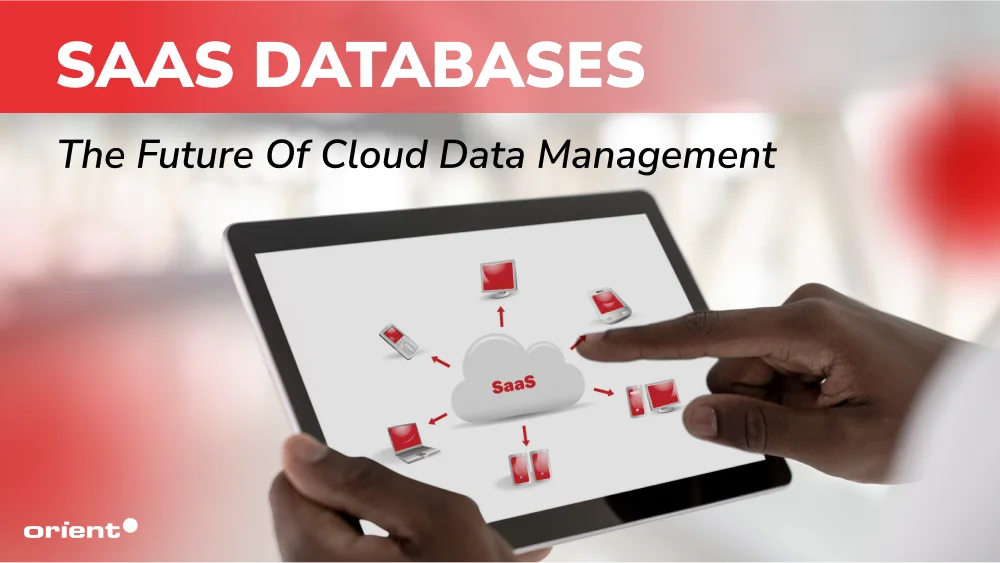
SaaS Databases: The Future of Cloud Data Management

Content Map
More chaptersToday’s fast-paced digital landscape comes with mountains of data. Managing massive data well unlocks the key to high performance, system efficiency, and cost savings.
A SaaS database plays a pivotal role in achieving such success. This article will cover everything you need to know about SaaS databases – what they are, their connection to multi-tenant architecture, and the benefits that your business can reap from them.
Key Takeaways:
- SaaS databases leverage cloud technology to provide scalable, cost-effective, and easily manageable data solutions.
- Multi-tenant architectures in SaaS databases optimize resources and reduce costs by permitting multiple users to share the same infrastructure while maintaining data isolation and customization.
- Various multi-tenant database design patterns - such as shared schema, separate schemas, and separate databases - offer different levels of data isolation, customization, and cost-effectiveness, catering to diverse business needs and security requirements.
Understanding SaaS Database

To understand the SAAS database, we first need to understand what a cloud-based database is. A cloud-based database is hosted on a cloud platform, offering the same functionality as traditional databases while providing additional benefits such as scalability, speed, and cost efficiency. It can be controlled by a cloud provider or an organization’s IT team. It is particularly handy for applications that require access across large networks, enabling connectivity from mobile devices and remote locations.
SaaS (Software-as-a-Service) is a method that allows users to access software without purchasing it outright. In the context of databases, a SAAS database lets users use and access the database without setting up hardware or the underlying infrastructure. Users can log into the database as part of a larger application.
SaaS Databases and Multi-Tenancy Architecture

In cloud computing, when it comes to SaaS applications and SaaS databases especially, the multi-tenancy architecture plays a paramount role in reducing costs and optimizing resources.
There are several key concepts that you need to know, including multi-tenancy, data isolation, tenant data management, and scalability.
Definition
A tenant is a group of people or organizations that share the same database. Multi-tenancy is a single application that serves multiple customers or tenants.
Well-known examples of this architecture include Azure SQL Database, Amazon Web Services (AWS), and Google Cloud Platform (GCP).
Components of Multi-Tenancy Architecture
To work effectively, multi-tenancy entails a number of crucial components:
- Shared Resources: Sharing resources is the core of this architecture. Tenants share databases, applications, and infrastructures.
- Data Isolation: Even though the software hosts multiple tenants, the tenant’s data should be kept both secure and separate. This is achieved via database schema or multi-instance architecture.
- Centralized Management: Any software updates and patches only need to be done once, and it will be available to everyone.
- Scalability: This model is built to be scalable - new tenants can be added to the application without much impact on the overall structure.
- Customization: Despite sharing the same resources, tenants can customize their space to a certain degree to meet their specific needs and business model.
Entities and Attributes in Databases for SaaS Applications

In a SaaS application database, entities are types of data that keep everything running smoothly. They include tenant data, user interactions, app settings, and system configurations. Each of these pieces plays a certain role in how the application functions and how it manages its users and operations. Here is a quick rundown of their categories and what they mean.
Tenant Table
- TenantID (Primary Key): Unique tenant identifier
- Tenant name and domain: Specific information regarding the tenant, like domain or organization name
- SubscriptionPlan: Information on the subscription plan and data limits.
- StorageQuota: Storage quota for each tenant.
User Table
- UserId (Primary Key): Unique user identifier
- Username, email: User’s login credentials and information
- TenantID: Tenant’s unique identifier linked to the user.
- Role: A user’s position or set of rights within a SaaS program.
Table of Configurations
- The primary key, or ConfigID, is a special designation for every configuration option.
- SettingName, SettingValue: Per tenant configurable settings and options.
Multi-Tenant Database Design Patterns
When it comes to multi-tenant databases, there are three primary patterns or models to consider.
Shared Database, Shared Schema
In this pattern, just as its name suggests, all tenants share the same database and database schema. It is often easy to set up and simple to manage.
- Resource Optimization: This is the highest level of resource optimization, and every tenant shares the same storage resources and server.
- Uniformity: The same storage resource and server means the data structure is the same, making maintenance and updating easy.
- Data Isolation: Data is kept separate for each tenant by using unique tenant identifiers within the database. These identifiers are typically included in the primary key of sharded tables (a table divided into manageable pieces), ensuring that each tenant’s data remains distinct and secure.
- Cost-Effectiveness: The most cost-effective design pattern due to its high degree of sharing. It is easily scalable as new tenants added don’t affect the data structure.
- Potential drawbacks: Poor data isolation may lead to security issues. Also, customization is limited, as one configuration can easily affect the rest. Performance might become a problem.
- This pattern is suitable for you when:
- The number of tenants is small.
- Similar data structure and security requirements.
- Priorities are resource efficiency and simplicity.
Shared Database, Separate Schemas
This pattern is a slight upgrade from the previous pattern. While still sharing the same database, each tenant has their own schema. Data isolation is improved as each tenant has a unique schema structure.
- Improved data isolation and customization: Each tenant’s database structure is kept separately with a higher level of customization.
- Balance: This pattern strikes a balance between resource sharing and the ability to cater to different tenant’s needs.
- Potential drawbacks: The need to maintain multiple schemas increases the complexity.
- This pattern is suitable for you when:
- Tenants have diverse data structures and security needs.
- Priorities lie in tenant isolation and customization.
- Resource efficiency and simplicity aren’t emphasized as much.
Separate Databases
This is the highest level of tenant isolation. Every tenant has a completely separate and dedicated database.
- Maximum flexibility: tenants have the highest degree of freedom to design and customize their data schema and how they choose to manage data.
- Independent scaling: Maxim isolation allows tenants to scale separately and have more freedom in resource allocation.
- Maintenance: Updates and maintenance can be performed per tenant, preventing potential widespread risks.
- Potential drawbacks: Typically, more expensive and the management is often more complex with potentially underutilized resources. StormForge found that an average of 47% of cloud resources are being squandered by organizations.
- This pattern is suitable for you when:
- You have a small number of tenants, but the data sensitivity and highland security demands are unique.
- Priorities are data isolation and security.
Hybrid Approach
This data model is a mixed approach of the shared database and a separate database approach. Most SaaS companies choose this hybrid design pattern where larger organizations get their dedicated database while smaller tenants share their resources.
- Flexible: The Saas application can meet everyone’s needs. While one tenant has a dedicated database and schema to customize and enjoy full data isolation, other smaller tenants share more commonalities.
- Scalability and Adaptability: Every tenant’s scaling meets are met, with resources allocated dynamically.
- Potential Drawbacks: Management of shared and shared databases is complex, so it needs to be planned carefully to balance both.
- Maintaining consistent performance can be challenging.
- This pattern is suitable for you when you have tenants with diverse database needs.
Benefits of Saas Database and Multi-Tenant Model
Let’s go over all the benefits of the SaaS database and the multi-tenant model once again:
- Reduced Risk of Loss Data: With all data stored in the cloud, disaster recovery in cases of natural disasters or equipment failure is much easier to manage.
- Scalability - Up and Down: You can easily access more storage and computer capacity should you need it. Database clusters can also be scaled down if you don’t demand as much space anymore.
- High Availability: A SaaS database ensures you can access data anywhere and anytime, maximizing productivity.
- Less Costly Management: Gone are the days of going back and forth about the database administrative tasks. The cloud provider will handle all these aspects for you, giving the in-house IT team more time and space to work on core business activities.
- More Revenue: A survey by Infosys indicates that migrating to the cloud can boost profit growth by 11.2% annually, with at least 60% of an organization’s workload in the cloud.
- Data Security: SaaS databases typically come with enterprise-level security to protect tenants’ data integrity. Some even meet industry-specific standards.
However, choosing SAAS databases also means that you will rely more on the internet and even lack some database control, so consider these elements when choosing your type of preferred database.
Secure Your Top-Notch SaaS Database with Orient Software
Every organization deserves a high-performing, cost-effective database solution. At Orient Software, we deliver secure, user-friendly, and responsive databases that align with your business strategy. Our expertise includes specialized services such as data migration, database optimization, and refactoring. Let us help you elevate your database performance - contact us today to get started!






